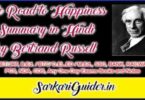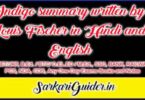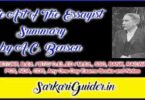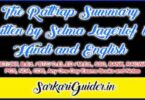Gilbert Keith Chesterton

Gilbert Keith Chesterton as an English writer
Life and Works
Introduction
Gilbert Keith Chesterton was an English writer of the early 20th century. Chesterton was known as the “prince of paradox”. Many of Chesterton’s works remain in print, including collections of his father Brown detective stories, and Ignatius Press is presently undertaking the monumental task of publishing his complete works.
Birth, education and early writing
Born in Campden Hill, Kensington, London, Chesterton was educated at St. Paul’s School, and later went to the Slade School of Art in order to become an illustrator. In 1900, Chesterton was asked to write a few magazine articles on art criticism, which sparked his interest in writing. He went on to become one of the most prolific writers of all time. Chesterton’s writings displayed a wit and sense of humour that is unusual even today while ofter making extremely serious comments on the world, government, politics, economics, philosophy, theology and many other topics.
His Writings
Chesterton wrote around 80 books, several hundred poems, 200 short stories, 4,000 essays and a few plays. He was a columnist for the Daily News, Illustrated London News, and his own paper, G. K’s Weekly. In the United States, his writings on distributism were popularized through The American Review, published by Seward Collins in New York. He was a literary and social critic, historian, playwright, novelist Catholic Christian theologian and apologist, debater and mystery writer. His most well known character is the priest-detective Father Brown, who appeared only in short stories, while The Man Who Was Thursday is arguably his best-known novel. He converted to Roman Catholicism in 1922. Christian themes and symbolism appear in mnch of his writing, and he often presented himself in the role of the Church’s champion.
The British writer Hilaire Belloc is often associated with his friend Chesterton. Although very different men, they had in common their Catholic faith and a critical attitude to both capitalism and socialism. Both are figures likely to outlast many of their more celebrated literary contemporaries.
His figure
Chesterton was a large man, standing 6 feet 4 inches (1.93 m) and weighing around 21 stones (134 kg). Chesterton had a unique look, usually wearing a cape and a crumpled hat, with a swordstick in hand, and usually a cigar hanging out of his mouth. Chesterton rarely remembered where he was supposed to be going and would even miss the train that was supposed to take him there. It was not uncommon for Chesterton to send a telegram to his wife. Frances Blogg, whom he married in 1901, from some distant (and incorrect) location writing such things as, “Am at Market Harborough. Where ought I to be ?” to which she would reply “Home.”
Conclusion
Chesterton loved to debate often publicly debating with friends such as George Bernard Shaw, H. G. Wells, Bertrand Russell, and Clarence Darrow. Chesterton was usually considered the winner. According to his autobiography, he and George Bernard Shaw played cowboys in a silent movie.
गिलबर्ट केथ चैस्टरटन : जीवन परिचय एवं कृतियाँ
प्रस्तावना
गिलबर्ट केथ चैस्टरटन प्रारम्भिक बीसीं शताब्दी का (1874 1936) अंग्रेजी भाषा का लेखक था। वह विरोधोक्ति का राजकुमार (Prince of Paradox) के रूप में जाना जाता था। उसके कई ग्रन्थ छपने शेष हैं। इसमें उसके पिता Brown की detective stories भी सम्मिलित हैं। प्रेस उसकी पूर्ण रचनाओं को छापने में लगा है। उसकी कई रचनाएँ प्रकाशित हो रही हैं।
जन्म, शिक्षा तक प्रारम्भिक लेखन कार्य
उसका जन्म Campden Hill, Kensington, लन्दन में हुआ था। उसकी प्रारम्भिक शिक्षा सेंट पॉल विद्यालय में हुई। बाद में वह 1900 में illustrator बनने के लिए Slade School of Art में गया। चैस्टरटन से कहा गया कि वह art criticism के लिए कुछ लेख लिखे जिससे उसे लिखने की प्रेरणा और रुचि मिली। वह सार्वभौमिक व सफल लेखकों में एक लेखक बनता गया। चैस्टरटन की रचनाओं में हास, परिहास, व्यंग्य के साथ-साथ सरकारी राजनीति, अर्थशास्त्र, मनोविज्ञान, वेदान्त और अन्य अनेक विषयों पर गम्भीर आलोचना भी मिलती है। चैस्टरटन सरल भाषा के हास्य व्यंग्यपूर्ण विधि से इनकी आलोचना करता था।
उसके ग्रन्थ
चैस्टरटन ने लगभग 80 पुस्तकें, कई सौ कविताएँ, 200 लघु कहानियाँ, 4,000 निबन्ध और कुछ नाटक लिखे। वह Daily News, Illustrated London News तथा अपने स्वयं के अखबार का सम्पादक था। United States के न्यूयार्क में Seward Collins द्वारा ‘The American Review’ में उसकी रचनाएँ प्रकाशित होती थी। उसके द्वारा ये प्रसिद्ध हुईं।
उसकी बहुमुखी प्रतिभा
वह एक साहित्यिक और सामाजिक लेखक, इतिहासकार, नाटककार, उपन्यासकार, कैथोलिक ईसाई, वेदान्ती, क्षमा की प्रार्थना करने वाला, डिबेटर और रहस्यात्मक लेखक था। उसका सर्वाधिक प्रसिद्ध चरित्र priest detective, Father Brown का था जो केवल लघु कहानियों में ही प्रकट हुआ। उसके सबसे अधिक प्रसिद्ध उपन्यास में वह The Man who was Thursday रूप में प्रकट हुआ। उसने 1922 में Roman Catholicism स्वीकार किया। उसकी रचनाओं में उसका अन्य रूप मिलता है। वह अक्सर स्वयं को चर्च के चैम्पियन के रूप में प्रकट करता था।
ब्रिटिश लेखक Hilaire Belloc उसके मित्र चेस्टरटन के साथ रहता था। यद्यपि वह बिल्कुल विभिन्न प्रकार का व्यक्तित्व रखता था। वे दोनों कैथोलिक धर्म को मानते थे और वे पूँजीवाद और समाजवाद दोनों की आलोचना करते थे। वे दोनों साहित्यिक क्षेत्र में समवयस्क थे।
चैस्टरटन की आकृति
चैस्टरटनं एक लम्बा व्यक्ति था जिसकी ऊँचाई 6 फीट 4 इंच (1.93 मी) थी और उसका भार लगभग 21 स्टोन (134 किलो) था। वह देखने में अनूठा था। वह अक्सर ढीला चोगा तथा टोप पहनता था, उसके हाथ में तलवार की छड़ी होती थी और मुँह में सिगार जली रहती थी। वह यह भूल जाता था कि उसे कहाँ जाना है। अत: उससे रेलगाड़ी छूट जाती थी। वह अपनी पत्नी को तार भेजता था। उसने 1901 में Francis Blogg से विवाह किया था।
उपसंहार
चैस्टरटन को डिबेट करना बहुत पसन्द था। वह अक्सर अपने मित्र जॉर्ज बर्नार्ड शॉ, एच जी. वेल्स, बरट्रैण्ड रसैल और कलेरेन्स डैरो आदि के साथ सार्वजनिक रूप से डिबेट करता था। चैस्टरटन अक्सर डिबेट में जीत जाता था। उसकी आत्मकथा के अनुसार वह और जॉर्ज बर्नार्ड शॉ गायों के रखवाले के रूप में खेलते थे।
Important Links
- John Keats Biography
- Percy Bysshe Shelley Biography
- William Wordsworth as a Romantic Poet
- William Wordsworth as a poet of Nature
- William Wordsworth Biography
- William Collins Biography
- John Dryden Biography
- Alexander Pope Biography
- Metaphysical Poetry: Definition, Characteristics and John Donne as a Metaphysical Poet
- John Donne as a Metaphysical Poet
- Shakespeare’s Sonnet 116: (explained in hindi)
- What is poetry? What are its main characteristics?
- Debate- Meaning, Advantage & Limitations of Debate
- Sarojini Naidu (1879-1949) Biography, Quotes, & Poem Indian Weavers
- Charles Mackay: Poems Sympathy, summary & Quotes – Biography
- William Shakespeare – Quotes, Plays & Wife – Biography
- Ralph Waldo Emerson – Poems, Quotes & Books- Biography
- What is a lyric and what are its main forms?






